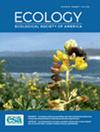在较暖的温度和较小的生态系统规模下,减少了湖鳟鱼食物网的种内变异
IF 4.3
2区 环境科学与生态学
Q1 ECOLOGY
引用次数: 0
摘要
食物网理论表明,移动的顶级捕食者,如湖鳟鱼(Salvelinus namaycush),可以成为食物网的强有力的稳定器,因为它们有能力根据变化的条件改变觅食行为。与此一致的是,研究表明,平均湖鳟鱼食物网属性(即营养位置和近岸耦合)在不同的环境梯度中发生结构变化;然而,这些属性跨梯度的种内变化尚未得到充分探讨。在这里,我们使用基于稳定同位素的食物网指标来研究加拿大北方防护林湖泊营养结构的平均和种内变化如何在生态系统规模、温度和竞争梯度中变化。与早期的研究结果一致,我们发现随着夏季气候变暖,近岸耦合减少,营养地位增加。与以往的研究结果相反,湖泊面积的增加预示着近岸耦合的增加,与湖鳟鱼的营养地位无关。我们的研究结果表明,较高的温度和较小的生态系统规模减少了食物网结构中种内变异的表达。具体而言,较大的湖泊增加了近岸耦合和营养位置的变化,导致生态位面积更大,而较暖的湖泊减少了近岸耦合的变化,并倾向于产生较小的生态位面积。有趣的是,我们发现很少有证据表明湖鳟鱼或其他捕食者分类群(种内和种间竞争的替代品)的相对丰度影响湖鳟鱼营养结构的平均值和方差。种内变异可以促进生态系统的恢复力,使不同的个体反应有助于缓冲种群对环境变化的影响。因此,在较小、较暖的湖泊中,种内变化的减少可能会对加拿大北方防护林湖泊中的湖鳟鱼和生物群产生不良后果,使这些生态系统无法适应未来的扰动。本文章由计算机程序翻译,如有差异,请以英文原文为准。
Reduced intraspecific variation in lake trout food webs under warmer temperatures and smaller ecosystem sizes
Food web theory has illustrated that mobile top predators, such as lake trout (Salvelinus namaycush ), can be potent stabilizers of food webs due to their ability to shift foraging behaviors in response to changing conditions. Consistent with this, research has demonstrated that mean lake trout food web attributes (i.e., trophic position and nearshore coupling) structurally change across environmental gradients; however, intraspecific variation in these attributes across gradients has not been fully explored. Here, we used stable isotope‐based food web metrics to investigate how both mean and intraspecific variation in trophic structure changes in Canadian boreal shield lakes across gradients in ecosystem size, temperature, and competition. Consistent with earlier findings, we find nearshore coupling decreases and trophic position increases with warmer summer climate. In contrast to previous findings, increasing lake area predicted increased nearshore coupling and was not associated with lake trout trophic position. Our results show that warmer temperatures and smaller ecosystem sizes reduce the expression of intraspecific variation in food web structures. Specifically, larger lakes increased variation in nearshore coupling and trophic position, resulting in larger niche areas, and warmer lakes reduced variation in nearshore coupling and tended to generate smaller niche areas. Interestingly, we found little evidence for the relative abundance of lake trout or other predator taxa (surrogates of intra‐ and interspecific competition) influencing mean and variance in lake trout trophic structure. Intraspecific variation can promote ecosystem resilience by enabling diverse individual responses that help buffer populations against environmental change. Therefore, reduction in intraspecific variation in smaller, warmer lakes may have undesirable consequences for lake trout and the biota in these Canadian boreal shield lakes, leaving these ecosystems less able to adjust to future perturbations.
求助全文
通过发布文献求助,成功后即可免费获取论文全文。
去求助
来源期刊

Ecology
环境科学-生态学
CiteScore
8.30
自引率
2.10%
发文量
332
审稿时长
3 months
期刊介绍:
Ecology publishes articles that report on the basic elements of ecological research. Emphasis is placed on concise, clear articles documenting important ecological phenomena. The journal publishes a broad array of research that includes a rapidly expanding envelope of subject matter, techniques, approaches, and concepts: paleoecology through present-day phenomena; evolutionary, population, physiological, community, and ecosystem ecology, as well as biogeochemistry; inclusive of descriptive, comparative, experimental, mathematical, statistical, and interdisciplinary approaches.
 求助内容:
求助内容: 应助结果提醒方式:
应助结果提醒方式:


